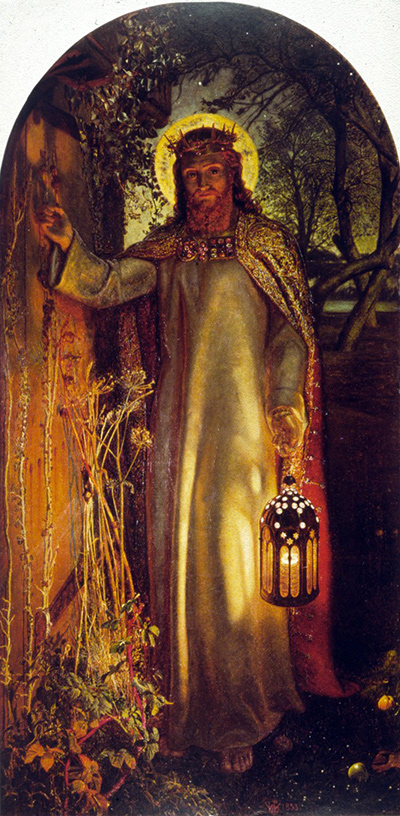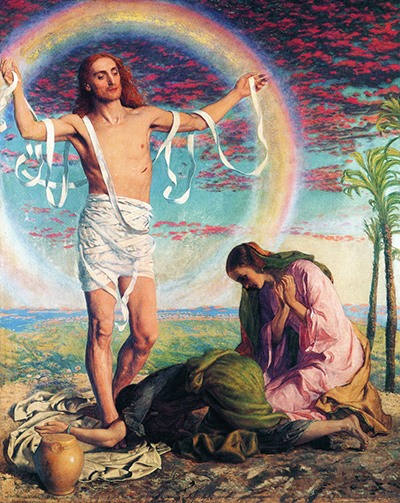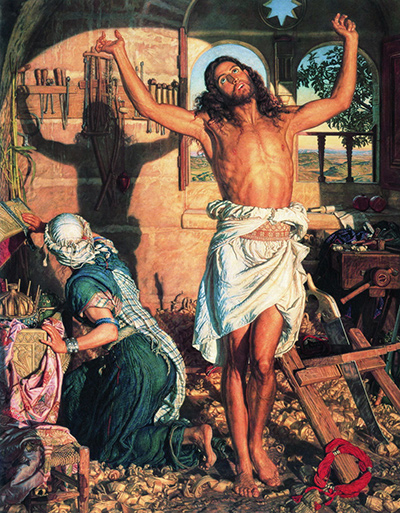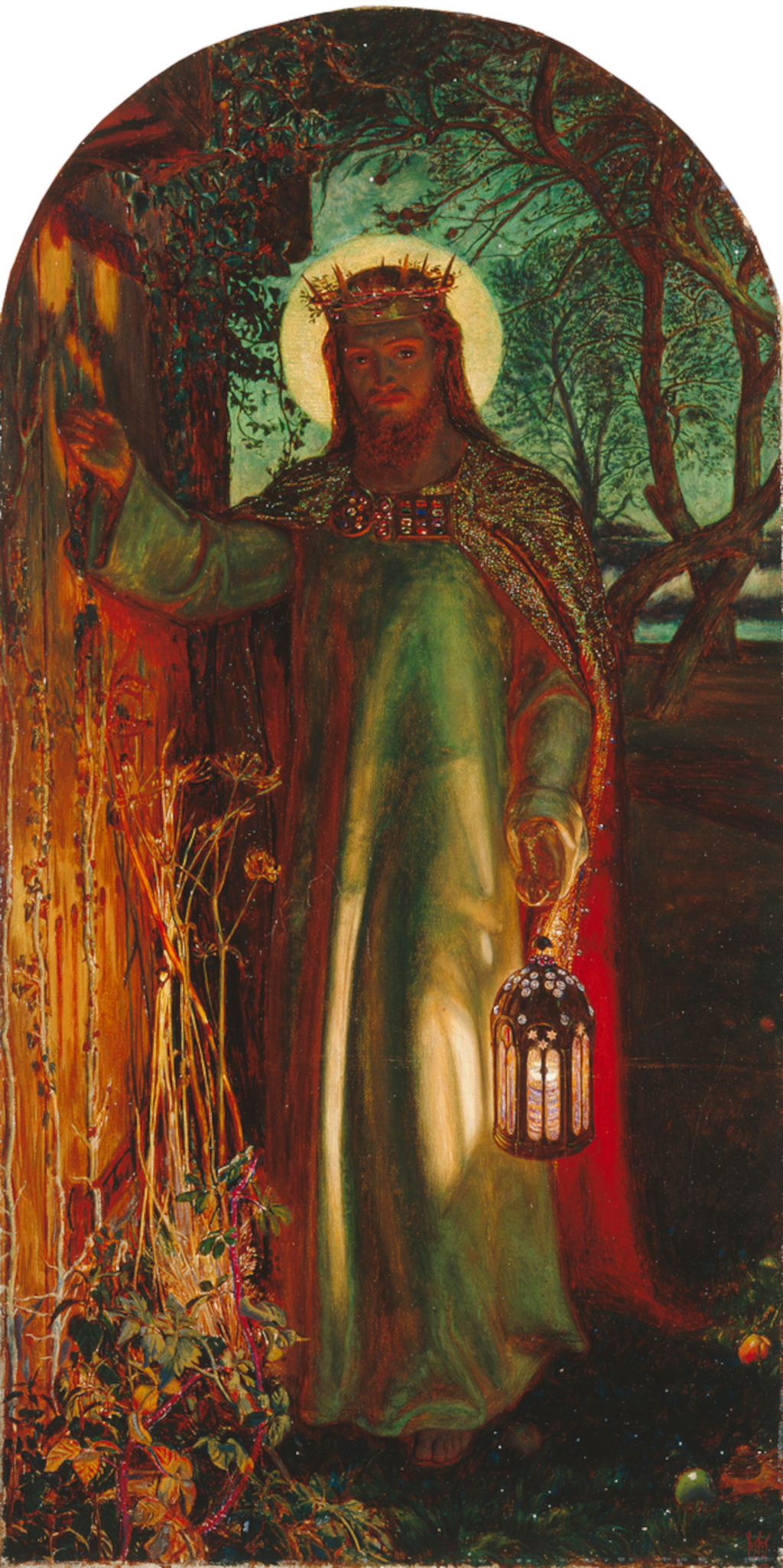The Light of the World is a painting in oil on canvas, produced in the early 1850s by the English artist William Holman Hunt (1827–1910). It is considered one of the most significant allegorical works of the Pre-Raphaelite movement.
Biblical Inspiration
The painting depicts a Biblical scene, specifically Revelation 3:20, in which Jesus says "Behold, I stand at the door and knock". Hunt painted the door as ancient and overgrown with no external handle, in order to represent the problems of a closed mind.
Description
William Holman Hunt's The Light of the World pictures Jesus Christ dressed in a long, golden robe carrying a decorative lantern. He is making his way through a dense forest, late at night. Christ's halo shines brightly, with his figure placed centrally in order to attract the focus of the viewer some have suggested that it is not in fact a halo, but instead a representation of salvation.
Christ lifts his right hand, whilst looking directly at us. He is depicted as a relatively young man, albeit with a long, thick beard. A cloak hangs over his shoulders and is beautifully decorated, combining tones of gold and red. To the left hand side we find tall plants that provide a vertical balance to the painting.
The meaning of his raised hand is to signify Jesus knocking on the door, as written in the religious scripture. The door itself is placed on the left hand side, angled away from us, and the plants below are deliberately painted in an aged, limp condition, signifying how Jesus is arriving as a saviour.
In the background, various trees and branches encircle his halo, setting the scene perfectly, and just allowing a small amount of light to show through. The top of the canvas is curved, signifying how the work was originally intended to be hung within an agreed location, as opposed to a more standard, rectangular format.
The image below, offering more detail of Christ's image, shows how the artist reflected light from his cloak as well as his crown of thorns. William Holman Hunt managed to fuse the traditional themes of Christianity with British settings, which was a common route within 19th century art.
There maybe additional symbolise within the background of the work, with some suggesting that the trees perhaps represent an apple tree orchard. Such a fruit brings a wealth of meaning, when combined with Christian themes, including most notably the garden of Eden. It is unlikely that this would have been a mere coincidence, as Holman Hunt placed considerable thought and planning into the composition.
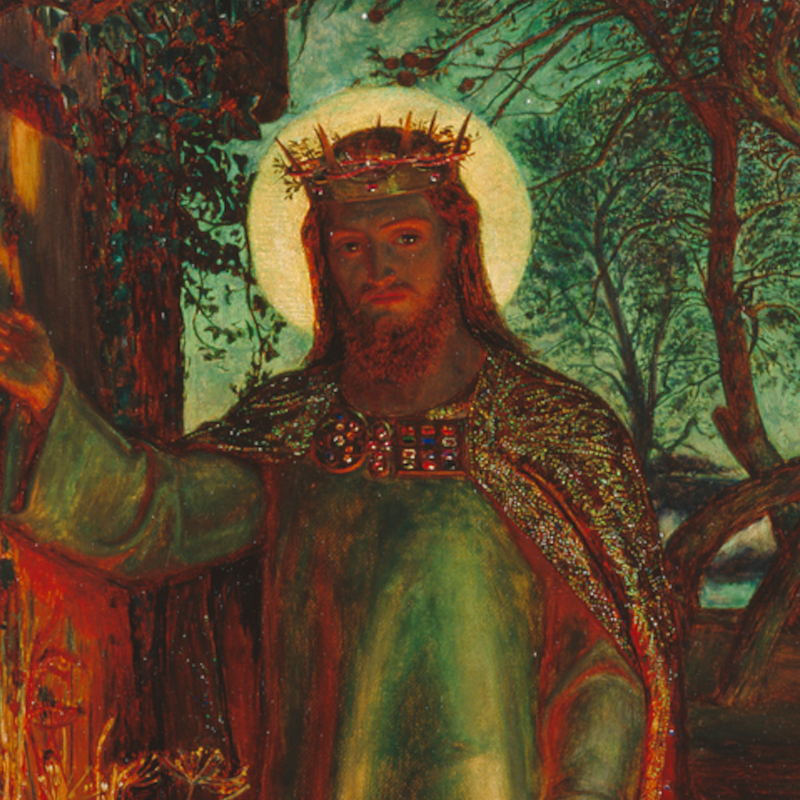 The Light of the World (Detail)
The Light of the World (Detail)
Religious Conversion
The Light of the World marked William Holman Hunt's conversion to Christianity, making it a highly significant work within his evolution as both an artist and also a human being. He lived predominantly as an atheist in his early years but recorded in his diaries about a change around the same time that he produced this painting.
Many of Holman Hunt's closest friends were keen followers of the Church, albeit in different guises, and over time he would join them. Whilst his religiously-themed artworks were deep and emotional, it is unclear as to how seriously he took some Christian beliefs, even after his apparent conversion. Whilst his diaries indicate a change in heart, he would never have quite the same commitment as some of his friends.
The study of his diaries, and our increased awareness of his switch from atheism to Christianity as his artistic career began to evolve, has allowed art historians to also spot subtle meanings within his work that otherwise may have gone unnoticed. Around the same time as The Light of the World, a number of other works from his career also feature references to biblical content, or more general moral guidance.
Production
The work took until 1853 to finish, and during this time he was also painting a smaller version later acquired by Manchester Art Gallery. Although the precise year of Hunt beginning work on The Light of the World is unknown, a date of c. 1850 is generally accepted.
Some sources claim that Hunt aided his representation of the pre-dawn setting by painting it after dark in a hut on a Surrey farm; others maintain that his location was the Oxford University Press garden. The distinctive lighting may have been informed by a journey to Bethlehem Hunt performed at about this time. Holman Hunt placed a great importance on accuracy within his work, which is why all three versions were somewhat delayed as he perfected the balance of light within each scene.
Upon the completion of The Light of the World, it was shown at the 1854 Royal Academy exhibition, and was very popular: Arthur Sullivan's oratorio of the same name is inspired by it. Many today consider Light of the World to be Holman Hunt's most famous painting of all.
Three Versions
Keble College
Almost twenty years later, a notable patron of Pre-Raphaelite artists, Thomas Combe, presented the painting to Keble College at Oxford University.
There was some controversy about this, since Combe wanted the work to hang in the chapel that was imminent, but William Butterfield, the building's architect, objected. It took until the early 1890s for the row to be resolved, with the construction of a new side chapel. The artwork continues to be displayed here today.
Manchester City Art Gallery
A second, smaller version came about just a few years later, with the artist believed to have worked on it between the years of 1851 and 1856. It has resided within the Manchester City Art Gallery since 1912, and this significant institution boasts an impressive selection of British art from the Victorian era.
Lifesize version, St Paul's Cathedral
Hunt was not pleased by Keble's decision to charge for admission to see his painting, so in 1900 he began work on a new, life-size version. Hunt was now elderly and in poor health, so asked for assistance from Edward Robert Hughes.
On the new work's completion four years later, it was bought by a wealthy shipowner, who took it on a hugely successful world tour. In 1908, the painting returned to England to be dedicated in its new home, St Paul's Cathedral. Hunt himself lived to see this, but not much longer: he died two years later, to be buried in St Paul's.
Further Religious Depictions by William Holman Hunt
As discussed earlier, Holman Hunt's decision to re-connect with his Christian routes was inspired by his belief that he had actually experienced the presence of God within his own life. From this point onwards many paintings would feature elements of Christianity, or morality. This selection made up some of the highlights of his career, as he was able to harness the emotion and power found within some of these themes.
The most obvious examples of this, besides The Light of the World, would have to be Christ and the two Marys, as well as The Shadow of Death. This change in direction brought about an additional segment of work which added another element to his varied and ambitious oeuvre. Works such as The Awakening Conscience offered a more subtle play on moralistic themes.
The Genres of William Holman Hunt
Religious and moral themes were far from the only sources of inspiration for this artist. Whilst a number of artworks featured here are considered amongst his best, there were many other notable pieces which had no connection to these themes at all. For example, Holman Hunt completed a number of portraits of his wife.
There were also elements of British and classical literature, both of which influenced a huge proportion of 19th century British artists. The artist also completed a number of landscape paintings, commissioned portraits of friends and family, as well as other scenes which were more in line with the Orientalist movement.
Large Image of The Light of the World
The stunning piece by William Holman Hunt is displayed below in a larger format. The version shown is from the Manchester City Art Gallery, which is actually the smallest of the three. There are variations between the three, mainly in their size, but most differences can only be seen when viewing each piece in person.



